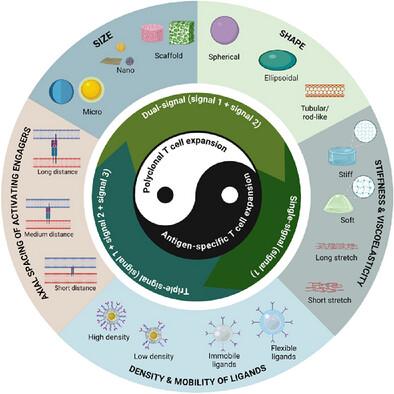设计和优化用于肿瘤免疫治疗中T细胞扩增的人工抗原提呈细胞策略
IF 19
1区 材料科学
Q1 CHEMISTRY, MULTIDISCIPLINARY
引用次数: 0
摘要
抗原呈递细胞(APCs),特别是树突状细胞(dc),在激活T细胞增强癌症免疫治疗中的免疫应答中起着关键作用。在癌症进展过程中,免疫抑制肿瘤微环境(TME)逐渐形成,保护肿瘤细胞免受免疫监视。TME造成的缺陷之一是功能失调的dc的存在,它触发抗原识别、加工和向T细胞呈递的失败,诱导抗肿瘤免疫反应的损害。在过继细胞治疗(ACT)中,由于天然dc的可用性有限和分离费力,通过替换自体dc来激活和扩增体外T细胞的需求是必不可少的。因此,模拟天然dc功能的人工APCs (aAPCs)的制造有望用于癌症免疫治疗,特别是在ACT中。本文综述了利用免疫突触的细胞信号传导原理设计aAPCs: T细胞受体(TCR)特异性激活(信号1)、共刺激信号(信号2)和细胞因子介导的信号(信号3)。特别讨论了配体的尺寸、形状、刚度、密度和迁移率的定制,以及活化接合剂的尺寸,以优化aAPCs。本文章由计算机程序翻译,如有差异,请以英文原文为准。

Strategies to Design and Optimize Artificial Antigen-Presenting Cells for T Cell Expansion in Cancer Immunotherapy
Antigen-presenting cells (APCs), particularly dendritic cells (DCs), play key roles in activating T cells for enhanced immune response in cancer immunotherapy. In cancer progression, an immunosuppressive tumor microenvironment (TME) is gradually developed, shielding tumor cells from immune surveillance. One of the defects created by the TME is the presence of dysfunctional DCs, which triggers failures in antigen recognition, processing, and presentation to T cells, inducing the impairment of anti-tumor immune responses. The demand for ex vivo T cell activation and expansion by the replacement of autologous DCs is imperative in adoptive cell therapy (ACT) due to the limited availability and the laborious isolation of natural DCs. Therefore, the fabrication of artificial APCs (aAPCs) mimicking the function of natural DCs holds promise for cancer immunotherapy, especially in ACT. This review concentrates on the design of aAPCs using the principles of cell signaling for the immunological synapse: T cell receptor (TCR)-specific activation (signal 1), co-stimulatory signal (signal 2), and cytokine-mediated signal (signal 3). Particularly, the customization of size, shape, stiffness, density, and mobility of ligands, as well as the dimension of activating engagers for the optimization of aAPCs, is also discussed.
求助全文
通过发布文献求助,成功后即可免费获取论文全文。
去求助
来源期刊

Advanced Functional Materials
工程技术-材料科学:综合
CiteScore
29.50
自引率
4.20%
发文量
2086
审稿时长
2.1 months
期刊介绍:
Firmly established as a top-tier materials science journal, Advanced Functional Materials reports breakthrough research in all aspects of materials science, including nanotechnology, chemistry, physics, and biology every week.
Advanced Functional Materials is known for its rapid and fair peer review, quality content, and high impact, making it the first choice of the international materials science community.
 求助内容:
求助内容: 应助结果提醒方式:
应助结果提醒方式:


